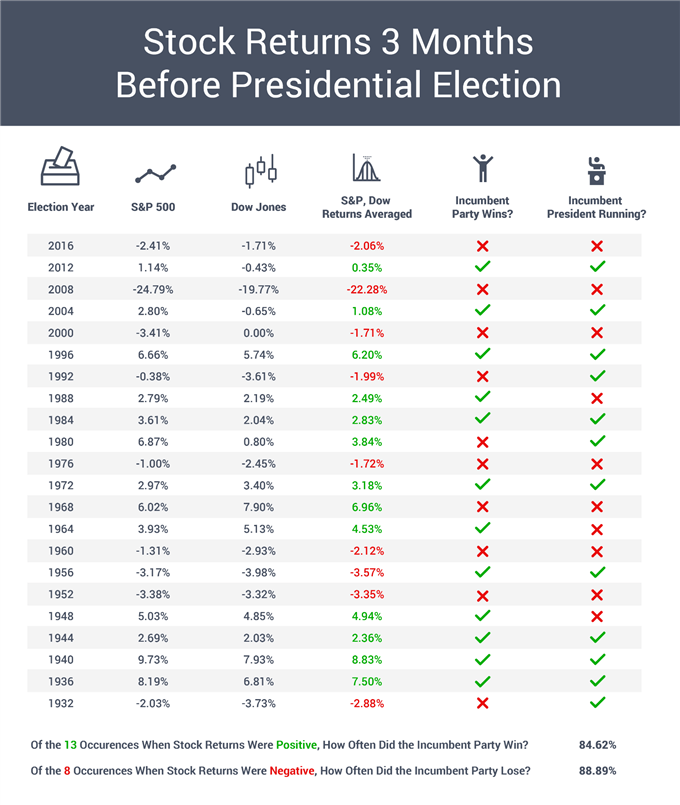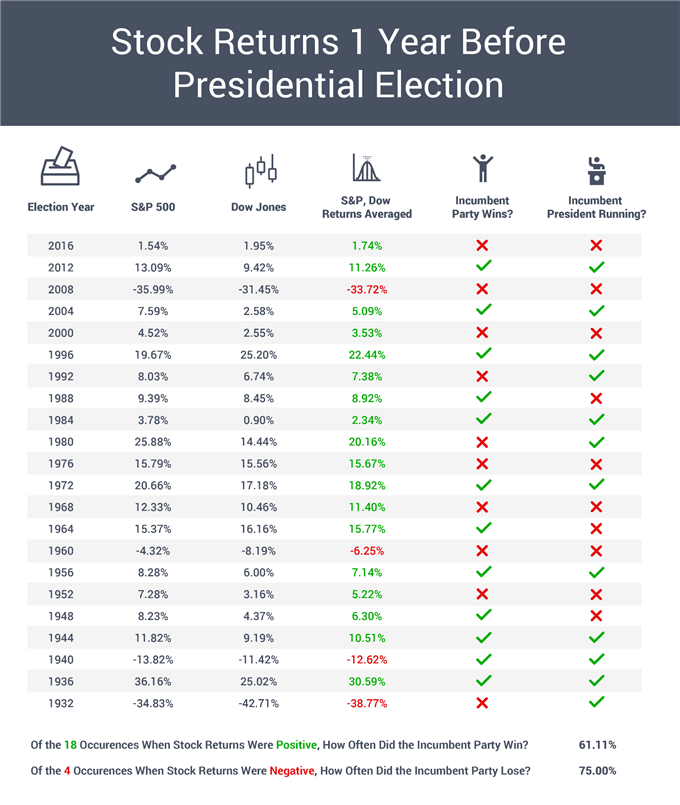HOW CAN STOCK MARKETS IMPACT US PRESIDENTIAL ELECTIONS?
How can returns in the Dow Jones, S&P 500 influence voters at the polls?
This study analyzes the indices 1 year and 3 months before elections
Do voters respond to stock performance as an election nears?
INTRODUCTION
Many factors can impact the outcome of US presidential elections, such as the shape of the economy, a voter’s background, turnout, outcomes in swing states and more. But what about returns in the stock market?
This is a special report that will analyze the performance of the S&P 500 and Dow Jones leading up to the 22 presidential elections since 1932. I will examine how the two indices performed on average one year and 3 months before an election, comparing their returns against whether or not the incumbent party won.
BACKGROUND
First, let us consider how might the performance in stocks influence elections in the first place? The price of a stock represents ownership of a fraction of a corporation, and is influenced by supply and demand forces reflecting the given firm’s expected fortunes. Some stocks will pay you a dividend and grant you voting access in shareholder meetings. But most importantly, you gain the right to sell the stock in the future.
If the price of a stock rises in value, the holder can make a profit by selling at a higher price than where they entered. If investors think that a business can make more returns in the future, boosting demand for their shares, then the price will often rise. There can be both specific and systematic forces that determine which way a stock can go. This piece focuses on the latter, or how the shape of the US economy as a whole drives stocks.
The S&P 500 and Dow Jones are stock indices that weight key sectors in the economy differently, such as information technology, real estate and energy. If their returns are positive heading into an election, this could be because investors expect the underlying businesses to generate more profits in the future. This could be due to a rosy outlook for economic growth, perhaps raising the odds of the incumbent party maintaining its grip on power.
Conversely, if stock returns are negative heading into an election, it could be due to a more pessimistic outlook for growth. If this is the case, then one might reasonably assume that the party running for reelection could be at a higher risk of losing its position. That is only the case, of course, if voters generally value the performance of stock markets. This is a limitation in this study, discussed in further detail at the end.
S&P 500, DOW JONES RETURNS 1 YEAR BEFORE PRESIDENTIAL ELECTION
Of the 22 elections since 1932, there were 18 instances when returns in the S&P 500 and Dow Jones one year before a presidential election averaged positive. Of those 18 occurrences, the incumbent party won 11 times, or about 61.11%. Returns in the stock market were negative the other 4 times. Of those, the incumbent party lost 3 times, or about 75% - see table below.
S&P 500, DOW JONES RETURNS 3 MONTHS BEFORE PRESIDENTIAL ELECTION
What happens in this study when the time frame changes from 1 year to 3 months before an election? In this case, of the 22 occurrences, there were 13 when stock returns were positive. Of those instances, 11 times, or 84.62%, the incumbent party won. Meanwhile, there were 8 instances when stock returns were negative. The incumbent party lost 7 times in this case, for about an 88.89% failure rate.
US 500MIXED Data provided by of clients are net short.
| CHANGE IN | LONGS | SHORTS | OI |
| DAILY | 2% | 0% | 1% |
| WEEKLY | -7% | 7% | 2% |
What does this mean for the S&P 500 outlook?
Get My Guide

CONCLUSION
In short, the 3-month data seems to offer more consistent outcomes compared to 1-year out. More often than not, the performance of the stock market closer towards an election seems to correlate with whether or not an incumbent party wins. It should be noted that correlation does not imply causation. It could be that voters place greater emphasis on stocks 3 months before an election as they pay more attention to current events in preparation for casting ballots. There are some limitations to this study.
STUDY LIMITATIONS
The election sample space is limited to 22, more observations tend to increase the accuracy of results.
This data does not take into account how much voters value stock returns around elections. According to Gallup, as of June 4 2020, about 55% of Americans reported owning stock.
This data does not take into account the depth of gains versus losses in stocks around election years. That is, do higher stock returns increase the likelihood of an incumbent party winning and vice versa?








